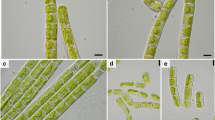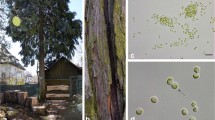Abstract
Lyngbya major (a wall alga), survived throughout year, maximally to >80 % at atmospheric temperature (AT) of 17–36 °C and relative humidity (RH) 60–100 % in rainy and spring seasons, but the survival was 43–64 % in winter when AT decreased to 5 °C and RH was 65–98 %, and 15–23 % in summer when AT reached 48 °C and RH was 23–60 %. All soil algae (Lyngbya birgei, Aphanothece pallida, Gloeocapsa atrata, Oscillatoria subbrevis, O. animalis) survived >90 % in rainy season when soil moisture content (SMC) was 89–100 %. Lowering of SMC to a minimum of 55 % in spring and 39 % in winter led L. birgei, O. subbrevis and O. animalis to survive from 75, 66, and 65 %, respectively, in spring and 12, 14, and 20 % in winter, and A. pallida and G. atrata not at all in both seasons. All soil algae did not survive in summer when SMC was 12–30 %. Myxosarcina burmensis survived only in rainy and spring seasons when pond water temperature (PWT) was 19–25 °C and 18–26 °C, respectively, and not in winter and summer when PWT was 2–14 °C and 25–36 °C, respectively. L. major and A. pallida survived almost equally well under both submerged and air-exposed conditions for 15 d but less if submerged for more time than air-exposed on moist soil surface, while L. birgei, G. atrata, O. subbrevis, and O. animalis survived submergence in liquid medium better and longer than air-exposure on moist soil surface. Pond alga M. burmensis survived submergence better than air-exposure, true to its aquatic habitat. All algae survived less and died without forming any resistant cells when exposed to physical and physiological water stress (imposed by growing them on highly agarized media or in salinized liquid media), light stress (at 0, 2 and 10 μmol m−2 s−1 light intensity) or following UV shock (0.96–3.84 kJ/m2). A. pallida and G. atrata cells did not divide on 8 % agarized solid media, in ≥0.3 mol/L salinized liquid media, and in darkness. The presence of sheath over L. major and L. birgei filament cells and mucilage cover over A. pallida and G. atrata cells protect them against physical desiccation to some extent but not against UV shock.
Similar content being viewed by others
Abbreviations
- AT:
-
atmospheric temperature
- RH:
-
relative humidity
- BG11:
-
liquid BG11 medium
- SMC:
-
soil moisture content
- PWT:
-
pond water temperature
References
Adir N., Zer H., Shochat S., Ohad I.: Photoinhibition: a historical perspective. Photosynth.Res. 76, 343–370 (2003).
Agrawal S.C., Pal U.: Viability of dried cells or filaments, survivability and/or reproduction under water and light stress, and following heat and UV exposure in some blue-green and green algae. Folia Microbiol. 48, 501–509 (2003).
Agrawal S.C., Singh V.: Viability of dried vegetative trichomes, formation of akinetes and heterocysts and akinete germination in some blue-green algae under water stress. Folia Microbiol. 44, 411–418 (1999).
Agrawal S.C., Singh V.: Viability of dried cells, and survivability and reproduction under water stress, low light, heat and UV exposure in Chlorella vulgaris. Israel J.Plant Sci. 49, 27–32 (2001).
Agrawal S.C., Singh V.: Viability of dried filaments, survivability and reproduction under water stress and survivability following heat and UV exposure in Lyngbya martensiana, Oscillatoria agardhii, Nostoc calcicola, Hormidium fluitans, Spirogyra sp. and Vaucheria geminata. Folia Microbiol. 47, 61–67 (2002).
Barbiero R.P., Welch E.B.: Contribution of benthic blue-green algae recruitment to lake populations and phosphorus translocation. Freshwater Biol. 27, 249–260 (1992).
Branco C.C.Z., Branco L.H.Z., Moura M.O., Bertusso F.R.: The succession dynamics of a macroalgal community after a flood disturbance in a tropical stream from Sao Paulo state, Southeastern Brazil. L. Revista Brasil.Botan. 28, 267–275 (2005).
Bristol-Roach B.M.: On the retention of vitality by algae from old stored soils. New Phytol. 18, 92–107 (1919).
Brown R.M. Jr., Larson D.A., Bold H.C.: Airborne algae: their abundance and heterogeneity. Science 143, 583–585 (1964).
Caiola M.G., Billi D., Friedmann E.I.: Effect of desiccation on envelopes of the cyanobacterium Chroococcidiopsis sp. (Chroococcales). Eur.J.Phycol. 31, 97–105 (1996).
Cameron R.E., Blank G.R.: Desert algae: soil crusts and diaphanous substrata as algal habitats. Jet Propulsion Laboratory Pasadena Tech.Rep. no. 32–971, pp. 1–45. Pasadena (USA) 1966.
Dembitsky V.M., Řezanka T.: Metabolites produced by nitrogen-fixing Nostoc species. Folia Microbiol. 50, 363–392 (2005).
Elliott J.A., Jones I.D., Thackeray S.J.: Testing the sensitivity of phytoplankton communities to changes in water temperature and nutrient load, in a temperate lake. Hydrobiologia 559, 401–411 (2006).
Erdmann N., Schiewer U.: Cell size changes as indicator of salt resistance of blue-green algae. Arch.Hydrobiol. 67(Suppl.), 431–439 (1984).
Garcia-Pichel F., Castenholz R.W.: Occurrence of UV-absorbing, mycosporine-like compounds among cyanobacterial isolates and an estimate of their screening capacity. Appl.Environ.Microbiol. 59, 163–169 (1993).
Garcia-Pichel F., Sherry N.D., Castenholz R.W.: Evidence for an ultraviolet sunscreen role of the extracellular pigment sctonemin in the terrestrial cyanobacterium Chlorogloeopsis sp. Photochem.Photobiol. 56, 17–23 (1992).
Geitler L.: Studien über das Haematochom und die Chromatophoren von Trentepohlia. Österr.Bot.Z. 73, 76–83 (1923).
Gupta S., Agrawal S.C.: Vegetative survival and reproduction under submerged and air-exposed conditions and vegetative survival as affected by salts, pesticides, and metals in aerial green alga Trentepohlia aurea. Folia Microbiol. 49, 37–40 (2004).
Gupta S., Agrawal S.C.: Survival of blue-green and green algae under stress conditions. Folia Microbiol. 51, 121–128 (2006a).
Gupta S., Agrawal S.C.: Motility in Oscillatoria salina as affected by different factors. Folia Microbiol. 51, 565–571 (2006b).
Gupta S., Agrawal S.C.: Survival and reproduction in some algae under stress conditions. Folia Microbiol. 52, 603–617 (2007a).
Gupta S., Agrawal S.C.: Survival and motility of diatoms Navicula grimmei and Nitzschia palea affected by some physical and chemical factors. Folia Microbiol. 52, 127–134 (2007b).
Harel Y., Ohad L., Kaplan A.: Activation of photosynthesis and respiration to photoinhibition in cyanobacteria within biological desert crust. Plant Physiol. 136, 3070–3079 (2004).
Hof T., Fremy P.: On Myxophyceae living in strong brines. Rec.Trav.Bot.Neerland 30, 140–162 (1933).
Holm-Hansen O.: Viability of lyophilized algae. Can.J.Bot. 42, 127–137 (1964).
Karandashova I.V., Elanskaya I.V.: Genetic control and mechanisms of salt and hyperosmotic stress resistance in cyanobacteria. Rus.J.Genet. 41, 1311–1321 (2005).
Krabs G., Wiencke C.: Effects of desiccation and irradiance during tidal cycles on the content of the mycosporine-like amino acids (MAAs) in Porphyra umbilicalis (L.) J. Ag. and Porphyra purpurea (Roth) C. Ag. Ber.Polar-und Meeresforsch. 484, 22–41 (2004).
Lange O.L., Kidron G.J., Budel B., Meyer A., Kilian E., Abeliovich A.: Taxonomic composition and photosynthetic characteristics of the “biological soil crusts” covering sand dunes in the Western Neger desert. Funct.Ecol. 6, 519–527 (1992).
Lu C., Vonshak A.: Effects of salinity stress on photosystem II function in cyanobacteria Spirulina platensis cells. Physiol.Plant. 114, 405–413 (2002).
Moore G.T., Carter N.: Further studies on the subterranean algal flora of the Missouri Botanical Garden. Ann.Missouri Bot.Garden 13, 101–140 (1926).
Petersen J.B.: Studies on the biology and taxonomy of soil algae, pp. 1–180 in Dansk Botanisk Arkiv Bd. 8 (no. 9). Dansk Botanisk Forening, Copenhagen (Denmark) 1935.
Řezanka T., Dembitsky V.M.: Metabolites produced by cyanobacteria belonging to several species of the family Nostocaceae. Folia Microbiol. 51, 159–182 (2006).
Scherer S., Potts M.: Novel water stress protein from a desiccation-tolerant cyanobacterium. J.Biol.Chem. 264, 12546–12553 (1989).
Sili C., Ena A., Materassi R., Vincenzini X.: Germination of desiccated aged akinetes of alkaliphilic cyanobacteria. Arch.Microbiol. 162, 20–25 (1994).
Sommer U.: Growth and survival strategies of planktonic diatoms, pp. 227–260 in Growth and Reproductive Strategies of Freshwater Phytoplankton (C.D. Sandgren, Ed.). Cambridge University Press, Cambridge (UK) 1988.
Stanier R.Y., Kunisawa R., Mandel M., Cohen B.: Purification and properties of a unicellular blue-green alga (order Chroococcales). Bacteriol.Rev. 35, 171–205 (1971).
Venugopal V., Prasanna R., Sood A., Jaiswal P., Kaushik B.D.: Stimulation of pigment accumulation in Anabaena azollae strains: effect of light intensity and sugars. Folia Microbiol. 51, 56–134 (2006).
Volkmann M., Gorbushina A.A.: A broadly applicable method for extraction and characterization of mycosporines and mycosporine-like amino acids of terrestrial, marine and freshwater origin. FEMS Microbiol.Lett. 255, 286–295 (2006).
Watanabe A.: Some devices for preserving blue-green algae in viable state. J.Gen.Appl.Microbiol. 5, 153–157 (1959).
Whitton B.A.: Effect of deep-freeze treatment on blue-green algal cultures. Brit.Phycol.Bull. 2, 177–178 (1962).
Wieland A., Kuehl M.: Regulation of photosynthesis and oxygen consumption in a hypersaline cyanobacterial mat (Camargue, France) by irradiance, temperature and salinity. FEMS Microbiol.Ecol. 55, 195–210 (2006).
Yamamoto Y., Nakahara H.: The formation and degradation of cyanobacterium Aphanizomenon flos-aquae blooms: the importance of pH, water temperature, and day length. Limnology 6, 1–6 (2005).
Author information
Authors and Affiliations
Rights and permissions
About this article
Cite this article
Gupta, S., Agrawal, S.C. Vegetative survival of some wall and soil blue-green algae under stress conditions. Folia Microbiol 53, 343–350 (2008). https://doi.org/10.1007/s12223-008-0053-7
Received:
Published:
Issue Date:
DOI: https://doi.org/10.1007/s12223-008-0053-7




